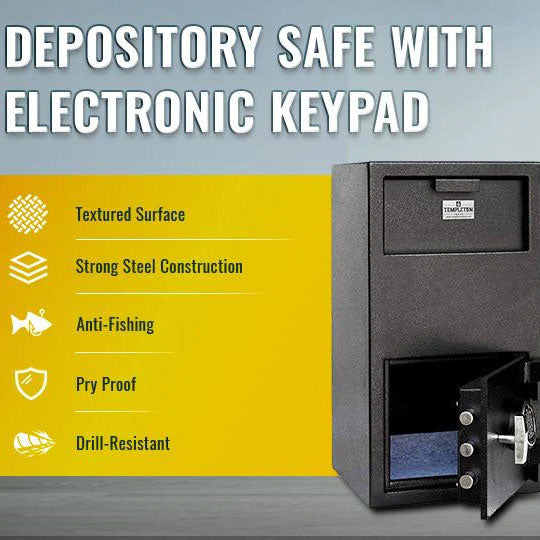How to Buy a Safe for Home: 4 Factors to Consider
When you’re looking to secure valuables in your home, whether it’s cash, important documents, jewelry, or heirlooms, choosing the right safe matters. If you’ve been browsing through Templeton Safes, you’ll see a wide variety of options ranging from heavy depository drop safes to smaller concealed safes for homes.
Below, we’ll walk through four key factors to consider when buying a safe for your home, using examples from Templeton Safes to help you make a confident and informed decision.
1. Purpose & Use Case: What Are You Securing and How?
Think About What You Need to Protect
The first step is to decide exactly what you’re protecting. Are you securing family heirlooms, firearms, important documents, or cash? Your purpose determines the size, fire rating, lock style, and visibility of your safe. Templeton Safes offers options suitable for both homes and businesses, making them a versatile choice for a wide range of security needs.
Drop Safes vs. Concealed Safes
If you’re interested in drop safes (also called depository safes), you’ll appreciate the convenience of depositing items without opening the main compartment. Templeton Safes’ Depository Drop Safe Collection includes models with anti-fishing deposit drawers, which prevent anyone from retrieving items once they’ve been dropped inside. This feature is especially useful for shared environments or cash deposits in small businesses.
By contrast, concealed safes are designed to be discreet. These are ideal for homeowners who want security without sacrificing aesthetics. Concealed safes can be hidden behind wall panels, inside closets, or even installed under the floor, allowing you to protect valuables without drawing attention to them.
Home Security Integration
A safe is only one part of your overall home security setup. Consider how it fits into your broader security plan. Does it anchor securely to a wall or floor? Is it located somewhere accessible during an emergency? Many Templeton Safes models include programmable digital locks, low-battery indicators, and backup keys to ensure consistent access and reliability.
2. Size, Construction, and Anchoring
Choosing the Right Size
The right safe size depends on what you plan to store. For example, the T865 Large Depository Drop Safe offers ample interior space for bulk storage. If you’re only securing documents, jewelry, or small electronics, a smaller safe designed specifically for homes may be more practical and easier to conceal.
Construction Quality and Locking Mechanisms
Durability is essential when buying a safe. Templeton Safes are known for their thick steel construction, triple-bolt action locking mechanisms, and anti-fishing drawers on drop models. These design elements ensure both strength and tamper resistance.
For any home safe, look for:
-
A solid steel body and reinforced door
-
Secure multi-bolt locking systems
-
Reliable locks (keypad, combination, or biometric)
-
Bolt-down mounting options for additional security
You can see these construction features clearly outlined on the T867 Standard Depository Drop Safe product page.
Anchoring and Environment
Even the strongest safe can be compromised if not properly anchored. For maximum protection, bolt your safe to a floor or wall to prevent it from being moved. If possible, install it in a concealed area like a closet or basement.
It’s also worth considering the environment. While Templeton Safes focuses primarily on theft protection, you can complement it with additional measures such as placing the safe in a dry, stable area to prevent moisture damage to your valuables.
3. Lock Style and Access Control
Different Lock Options
Safes come with several types of locks, and Templeton Safes offers some of the most user-friendly digital options available. Many models feature multi-user keypads that allow up to six user codes, giving multiple household members access without sacrificing security.
Common lock types include:
-
Electronic keypad locks: Fast and programmable for multiple users
-
Manual combination locks: Reliable and battery-free, though slower to open
-
Keyed locks: Simple, but risk losing keys
-
Biometric locks: Use fingerprint access for speed and convenience




Templeton’s digital keypad locks also include a dual-user mode, requiring two authorized codes for entry. Programming steps, lockout modes, and battery instructions are available on the Templeton Safes Product Manuals page.
Backup Access and Safety Features
Consider how the safe handles power or user errors. Templeton Safes locks retain codes even when the battery is changed. A low-battery indicator light alerts you before power runs out, and many models include a manual key override for emergencies. See details on the Templeton Safes Product Manuals page.
For peace of mind, make sure the safe you choose has:
-
A clear battery indicator
-
Manual key access for emergencies
-
A lockout period after multiple incorrect code entries
-
Easy code reprogramming options
4. Location, Concealment, and Cost
Where Should You Install Your Safe?
Placement is a key factor when it comes to safes for homes. Think about both security and convenience. Installing the safe in a closet, under stairs, or behind furniture helps conceal it from view.
If you choose a drop safe, make sure there’s enough clearance for the deposit drawer and door swing. Templeton Safes provides detailed specifications for each model so you can plan proper placement before installation.
Balancing Cost and Value
A home safe is an investment in peace of mind. Templeton’s models are built to last, using premium materials and design features typically seen in commercial-grade products. While prices vary depending on size and lock style, you’ll find the cost reflects the quality and durability offered.
Cheaper, lightweight safes can be more easily removed or broken into, so investing in a sturdy Templeton Safe is the smarter choice for long-term protection.
Warranty, Support, and Brand Reliability
Templeton Safes encourages buyers to register their safe for warranty protection and offers U.S.-based technical support to ensure customers receive assistance whenever needed. You can find warranty and setup details on the Templeton Safes support page.
When it comes to home security, choosing a reputable brand like Templeton ensures that help is available whenever you need it.
Bonus Tips for Buying and Installing a Home Safe
-
Check for fire and water resistance if you’re storing important documents.
-
Change the factory master code immediately after installation for added security.
-
Anchor the safe properly using hardware suited to your floor type.
-
Keep a record of stored contents for insurance purposes.
-
Test all access methods (codes, keys, batteries) to confirm reliability.
-
Reprogram access codes periodically to maintain safety.
-
Consider concealment to make your safe less visible to intruders.
Buying the right safe for your home involves balancing purpose, construction and size, lock style, and placement. Templeton Safes makes this process easier by offering durable, high-security safes that include thick steel construction, triple-bolt locking systems, multi-user keypads, and anti-fishing drawers for drop safes.
Whether you’re shopping for a drop safe for cash deposits or a concealed safe for discreet storage, Templeton Safes has a model to fit your needs. Each one combines strength, smart design, and long-term reliability to help you protect what matters most.
Explore the full lineup at Templeton Safes and choose the one that gives you complete confidence in your home security.






























